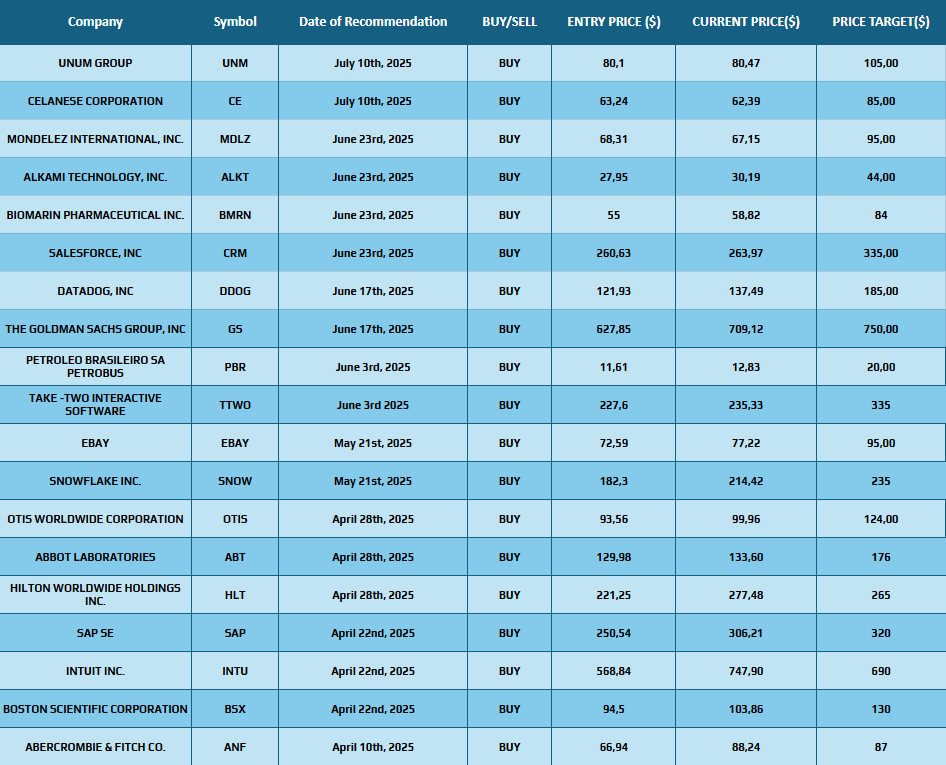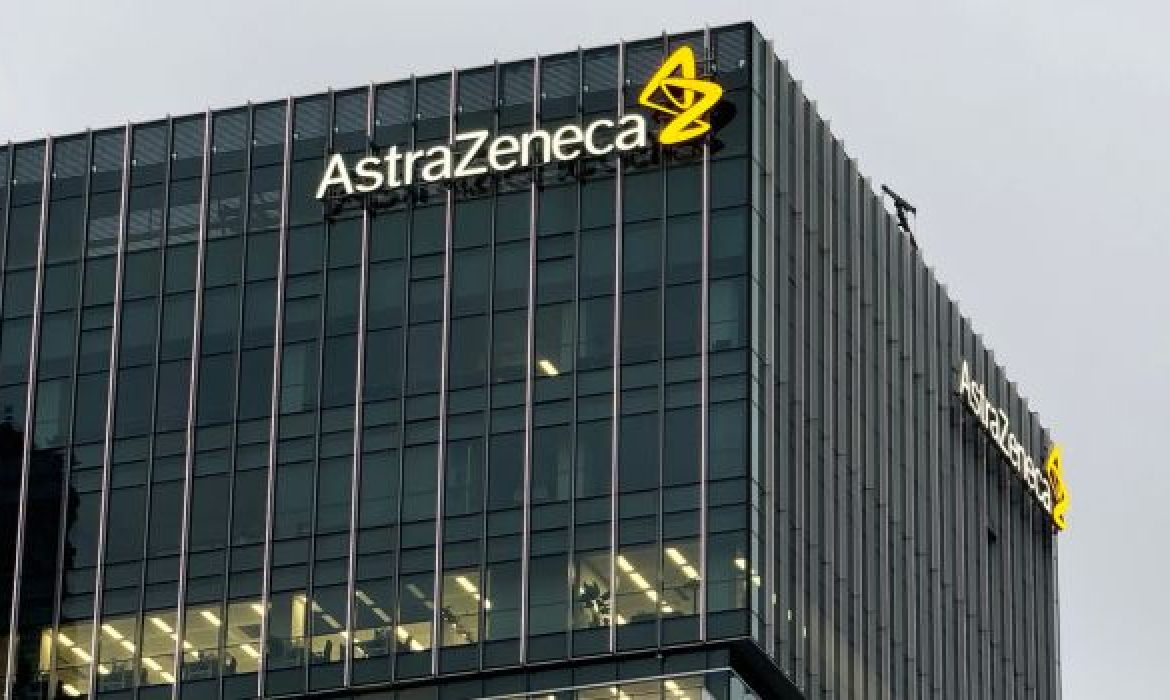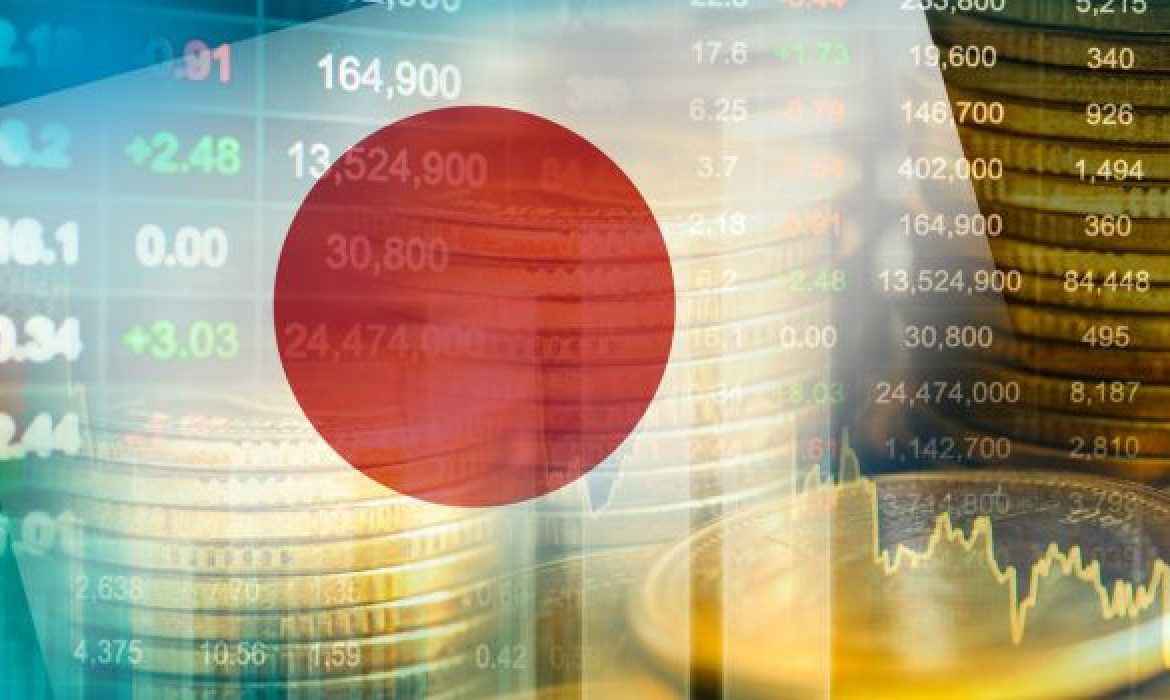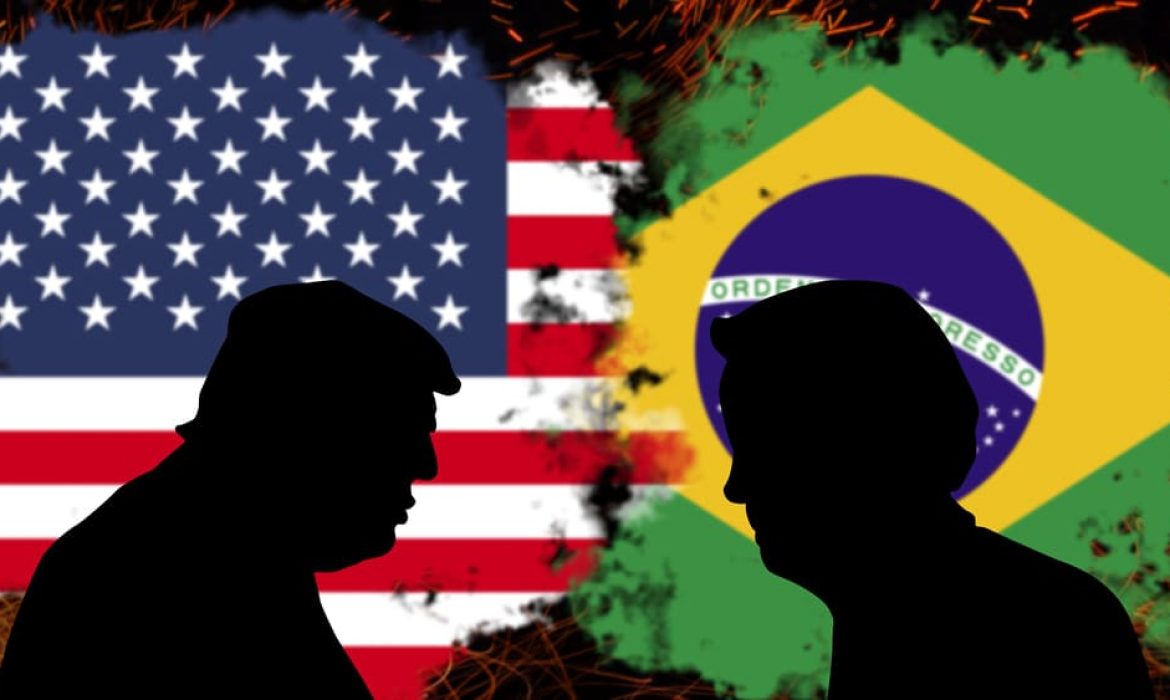Daily Synopsis of the New York market close – July 22, 2025
Date Issued – 22nd July 2025
Key Points
- AstraZeneca to invest $50 billion in the U.S. as pharma tariffs weigh: The pharma giant announced a record U.S. investment, including a Virginia-based GLP-1 production facility, as global drugmakers ramp up U.S. spending ahead of potential 200% tariffs under Trump’s reshoring push.
- China, Hong Kong shares extend rally on Tibet dam project boost: Chinese and Hong Kong equities hit multi-month highs, driven by construction and power stocks after Beijing launched a $170 billion hydropower project in Tibet, signaling renewed investor confidence amid easing U.S.-China tensions.
- Treasury yields creep higher as investors await Fed chair Powell’s speech: U.S. 10-year yields edged to 4.389% as markets awaited Powell’s comments on monetary policy, with investors assessing Fed independence amid Trump’s repeated criticism and calls for leadership changes.
- Dollar dithers as investors await more tariff clarity: The dollar held firm at 97.91, supported by solid U.S. economic data, while investors awaited developments on August 1 tariff deadlines, with the euro pressured by stalled EU-U.S. trade talks and escalating tariff risks.
AstraZeneca to Invest $50 Billion in the U.S.
AstraZeneca announced a $50 billion investment in U.S. manufacturing and R&D by 2030, underscoring the pharmaceutical industry’s shift to reshore operations amid looming trade tariffs. The centerpiece will be a multi-billion-dollar Virginia facility to produce its GLP-1 weight management drugs, integrating AI and automation to optimize production. Additional funding will expand operations in Maryland, Massachusetts, California, Indiana and Texas, creating tens of thousands of jobs.
CEO Pascal Soriot said the U.S. could account for half of the firm’s projected $80 billion annual revenue by 2030, as global drugmakers race to mitigate potential U.S. tariffs of up to 200%.
China, Hong Kong Shares Extend Rally on Tibet Dam Project Boost
Chinese and Hong Kong equities advanced, supported by construction and power firms after Beijing launched a $170 billion hydropower dam project in Tibet, billed as the world’s largest. The CSI300 Index rose 0.8% to an eight-month high, and the Hang Seng climbed 0.5% to 25,130, its highest level since November 2021. Anhui Conch Cement and Power Construction Co. hit the daily 10% limit, while the CSI Coal Index surged nearly 7%.
Sentiment was buoyed by easing U.S.-China tensions, Beijing’s policy support for long-term stock investments, and renewed confidence in manufacturing, though analysts caution economic headwinds may persist later this year.
Treasury Yields Creep Higher as Investors Await Fed Chair Powell’s Speech
U.S. Treasury yields inched higher Tuesday as markets awaited Federal Reserve Chairman Jerome Powell’s speech for policy signals. The 10-year yield rose to 4.389%, while the 30-year climbed to 4.959%, and the 2-year held near 3.865%. Investor focus remains on the Fed’s rate stance amid mounting political pressure, with President Donald Trump pushing for Powell’s removal and Treasury Secretary Scott Bessent questioning the Fed’s effectiveness and reluctance to cut rates despite subdued inflation.
With limited economic data this week, attention turns to Powell’s remarks and upcoming housing and durable goods figures for further rate outlook cues.
Dollar Dithers as Investors Await More Tariff Clarity
The dollar edged higher Tuesday, with the Dollar Index at 97.91, as traders awaited clarity on trade talks ahead of the August 1 tariff deadline that could impose steep duties on U.S. trading partners. The yen held most of Monday’s election-driven gains, while the euro eased to $1.1692 amid fading prospects for a U.S.-EU trade agreement and growing risk of tit-for-tat tariff escalation.
Market sentiment remains cautious, with investors weighing Federal Reserve independence concerns and potential inflationary pressures from tariffs. Analysts expect solid U.S. data and rate differentials to support the dollar, barring sudden shifts in White House policy.
Conclusion
Markets remain sensitive to geopolitical and macroeconomic catalysts: strong Chinese infrastructure signals support equities in Asia, while AstraZeneca’s bold U.S. move reflects ongoing supply-chain realignment under trade headwinds. In the U.S., modest Treasury yield rise and dollar resilience underscore investor caution ahead of Fed commentary and looming tariffs. Maintaining portfolio discipline—with exposure to real economy growth drivers, defensive U.S. yields, and currency hedges—can help navigate evolving risks and opportunities.
Investment Insights
China’s Infrastructure Push: The $170 billion Tibet dam project and supportive policy measures are reinforcing investor confidence in Chinese construction and power sectors, signaling potential upside in related equities despite longer-term economic headwinds.
Pharma Reshoring Trend: AstraZeneca’s $50 billion U.S. investment highlights a structural shift toward domestic biopharma manufacturing, benefiting U.S.-listed pharma suppliers and industrial automation players.
Fed Policy Uncertainty: Rising Treasury yields and scrutiny of the Federal Reserve increase volatility risk in bonds; short-duration bonds may offer a safer positioning until Powell’s policy stance is clarified.
Tariff-Driven FX Volatility: Dollar strength remains supported by solid economic data and tariff-induced inflation prospects, but escalating trade tensions could spur short-term volatility, favoring defensive positioning in safe-haven currencies like the yen and Swiss franc.
Upcoming Key Dates to Watch
| Date | Event | Why It Matters |
|---|---|---|
| Jul 22, 2025 | GBP Public Sector Net Borrowing (June) | Signals U.K. fiscal health, could affect sterling |
| Jul 22, 2025 | USD: Fed Chair Powell Speech | May influence interest rate outlook and bond yields |
| Jul 22, 2025 | USD: Richmond Manufacturing Index (July) | A gauge of regional manufacturing momentum |
| Jul 23, 2025 | EUR: ECB President Lagarde Speech | Insight into euro‑area monetary policy direction |
Daily Synopsis of the Asia market close – July 21, 2025
Date Issued – 21st July 2025
Key Points
- Australian Stocks Hit Record High: Australia’s S&P/ASX 200 surged to a record 8,757.2, supported by mining and biotech gains, while broader Asia-Pacific markets traded mixed following strong U.S. economic data and corporate earnings.
- Hedge Funds Exit Japanese Equities: Global hedge funds sold Japanese stocks at the fastest pace in over two months ahead of the upper house election, with political uncertainty adding to July’s underperformance in the Nikkei 225 and Topix.
- U.S. Rare-Earth Magnet Imports from China Jump 660%: American firms rushed to secure critical rare-earth magnets after a preliminary trade deal, highlighting U.S. dependency on China’s near-monopoly in advanced manufacturing components.
- U.S.-EU Tariff Tensions Escalate: Washington confirmed an Aug. 1 deadline for 30% tariffs on EU imports, pressuring Brussels to secure a deal as analysts warn even a 15%-20% rate could severely damage European exports, particularly in autos.
Australian Stocks Hit Record High Amid Mixed Asia-Pacific Trading
Australian equities surged to fresh record highs, with the S&P/ASX 200 closing 1.37% higher at 8,757.2, driven by gains in mining and biotech heavyweights such as BHP, Rio Tinto, and CSL. Asia-Pacific markets were mixed, as South Korea’s Kospi slipped 0.13% while China’s CSI 300 rose 0.6%. TSMC gained over 2% after posting a 61% jump in Q2 profit, underscoring sustained AI chip demand.
Meanwhile, Japan’s core inflation cooled to 3.3% in June, in line with expectations, while rice price easing supported the decline. Bitcoin rebounded above $120,000 as U.S. lawmakers advanced stablecoin regulation.
Hedge Funds Cut Japanese Equity Exposure Ahead of Election Setback
Global hedge funds sold Japanese equities at the fastest pace in over two months ahead of Sunday’s upper house election, Goldman Sachs reported. The Nikkei 225 is down 1.7% month-to-date, while the Topix has fallen 0.6%, underperforming global peers. The election dealt a political blow to Prime Minister Shigeru Ishiba, further pressuring sentiment, though he pledged to stay in office to conclude U.S. tariff negotiations.
Goldman noted hedge fund activity was driven by increased short positioning and moderate long reductions between July 11–17, reflecting heightened caution toward Japan’s political and economic outlook.
U.S. Rare-Earth Magnet Imports from China Surge Amid Supply Race
China’s exports of rare-earth magnets to the U.S. jumped 660% in June to 353 metric tons, as American firms rushed to secure supplies following last month’s preliminary trade framework between Washington and Beijing. The U.S., heavily reliant on imports for automotive, electronics, and renewable energy sectors, was China’s second-largest buyer after Germany. Total Chinese exports rose 160% from May to 3,188 metric tons but remained 38% below last year’s levels.
The surge highlights China’s dominance, controlling 90% of the rare-earth magnet market, and underscores the U.S.’s struggle to diversify supply despite recent recycling initiatives.
U.S. Holds Firm on Tariff Deadline as EU Scrambles for Deal
The U.S. reaffirmed its Aug. 1 deadline for imposing a baseline 30% tariff on EU imports, raising pressure on Brussels to strike a trade deal. Commerce Secretary Howard Lutnick said talks could continue after the deadline, but tariffs will take effect as planned. Economists warn that even a negotiated 15%-20% rate would severely hit European exports, particularly Germany’s auto sector, already pressured by euro strength.
The EU is preparing retaliatory measures, including levies on up to €72 billion of U.S. goods, signaling a tougher stance as it seeks a deal comparable to the U.K.’s lower-tariff framework.
Conclusion
Global markets are navigating a complex landscape where policy pressures and economic data are shaping sentiment. The EU’s new crude cap adds geopolitical weight, while U.S. and European earnings continue to buoy equity markets. Despite a softer dollar, underlying strength in U.S. retail and job figures suggests Fed caution. With both macroeconomic indicators and corporate results delivering surprises, investors should maintain flexibility as central bank communications and trade developments introduce volatility.
Investment Insights
Australian equities’ record high highlights investor rotation into resource-heavy markets amid strong commodity demand; selective exposure to mining and biotech remains attractive.
Hedge fund selloff in Japan ahead of elections suggests political risk repricing; long-term investors may find value opportunities if post-election policy stabilizes.
U.S. scramble for rare-earth magnets underscores supply chain vulnerabilities; companies securing alternative sourcing or recycling capabilities could gain a strategic edge.
U.S.-EU tariff tensions threaten European exporters, particularly autos; investors should monitor hedging opportunities and consider defensive positioning in EU industrials.
Upcoming Key Dates to Watch
| Date | Event | Why It Matters |
|---|---|---|
| Jul 22, 2025 | Fed Chair Powell speaks at banking conference | Signals on inflation and rate path guidance |
| Jul 23, 2025 | ECB policy meeting | Could explore rate adjustments amid euro strength |
| Jul 25, 2025 | U.S. Leading Index (June) & PPI YoY | Key data for assessing growth and inflation trends |
Daily Synopsis of the New York market close – July 18, 2025
Date Issued – 18th July 2025
Key Points
- S&P 500 Hits Fresh Record: The S&P 500 closed at a record 6,297.36, boosted by strong corporate earnings and better-than-expected U.S. retail sales, reinforcing optimism about consumer resilience.
- EU Tightens Russian Oil Sanctions: The EU approved its 18th sanctions package against Russia, introducing a lower price cap on Russian crude to further limit Moscow’s oil revenues while maintaining global supply stability.
- European Stocks Rise on Earnings Optimism: European indices edged higher, supported by positive earnings, with Burberry showing signs of recovery and Saab raising its sales forecast, while German producer prices confirmed weak inflation pressures.
- Dollar Pares Gains but Holds Weekly Strength: The U.S. dollar slipped 0.4% Friday but stayed on track for a second consecutive weekly gain as solid U.S. economic data delayed Fed rate-cut expectations.
S&P 500 Hits New Closing Record on Strong Earnings
U.S. stocks climbed Thursday, with the S&P 500 rising 0.54% to a record 6,297.36 and the Nasdaq gaining 0.75% to 20,885.65, marking its tenth record close this year. The Dow advanced 0.52% to 44,484.49. Investor sentiment was buoyed by robust corporate earnings — 88% of S&P 500 companies reporting so far have beaten estimates — and upbeat economic data. PepsiCo surged over 7% and United Airlines gained 3% after strong results. Retail sales rose 0.6% in June, well above forecasts, and jobless claims fell to 221,000, reinforcing confidence in U.S. consumer resilience.
EU Lowers Price Cap for Russian Crude Under New Sanctions Package
The European Union has approved its 18th sanctions package against Russia, introducing a lower oil price cap aimed at further squeezing Moscow’s energy revenues while maintaining global supply stability. The previous $60-per-barrel limit, set in December 2022, restricted non-G7 buyers from accessing G7 transport and insurance services if they paid above that price.
EU officials, including Commission President Ursula von der Leyen, said the new “dynamic” cap strikes at Russia’s war financing, while also sanctioning Rosneft’s largest refinery in India for the first time. Details of the revised cap level remain undisclosed.
European Stocks Gain on Earnings Optimism; Burberry Signals Recovery
European markets edged higher Friday, supported by strong corporate earnings and Wall Street’s overnight rally. Germany’s DAX rose 0.5%, France’s CAC 40 gained 0.6%, and the U.K.’s FTSE 100 added 0.2%. Burberry reported a smaller-than-expected 1% decline in Q1 comparable retail sales, hinting at a turnaround, while Saab raised its full-year growth forecast after a 32% surge in Q2 sales.
Reckitt Benckiser agreed to sell its Essential Home business for $4.8 billion, and Electrolux returned to profit. Brent crude rose 0.6% to $69.92 amid Iraqi supply disruptions, reinforcing concerns over tight global oil markets.
Dollar Slips but Remains on Track for Weekly Gain Amid Strong U.S. Data
The U.S. dollar edged lower Friday, with the Dollar Index down 0.4% to 98.10, but it remains on course for a 0.7% weekly gain as solid U.S. economic data bolstered expectations the Federal Reserve could delay rate cuts. Retail sales rebounded more than expected in June, jobless claims fell to a three-month low, and inflation rose at its fastest pace in five months, partly due to tariffs.
EUR/USD rose 0.3% to 1.1623, while GBP/USD climbed 0.2% to 1.3432 but remained set for weekly losses. USD/JPY traded at 148.63, weighed by political uncertainty in Japan.
Conclusion
Global markets are navigating a complex backdrop: EU tightening oil caps to pressure Russia, while U.S. equities hit fresh records underpinned by robust earnings and consumer data. In Europe, corporate results and earnings momentum in luxury and industrials are bolstering sentiment.
The dollar trades modestly lower but is set for weekly gains amid resilient U.S. economic indicators, even as Fed Governor Waller signals a likely rate cut by month-end. Meanwhile, Japan’s export slump underscores trade vulnerabilities as tariff talks with the U.S. stall. Investors should remain alert to monetary signals and geopolitical shifts that could reshape market risk across asset classes.
Investment Insights
- U.S. Equity Momentum: Record S&P 500 and Nasdaq closes, driven by strong earnings and resilient retail sales, signal continued investor confidence, favoring growth and consumer stocks, though valuations are becoming stretched.
- EU Sanctions & Oil Cap: The EU’s lowered price cap on Russian crude reinforces supply-side constraints, supporting medium-term bullishness in energy equities and oil-linked currencies. Investors should monitor potential retaliatory measures from Moscow.
- European Corporate Recovery: Positive earnings from Burberry, Saab, and Reckitt suggest selective opportunities in European luxury, defense, and consumer sectors despite lingering trade tensions.
- Dollar Strength: Strong U.S. economic data and delayed Fed rate-cut expectations continue to underpin dollar demand, benefiting dollar-denominated assets but pressuring emerging-market currencies.
Upcoming Key Dates to Watch
| Date | Event | Why It Matters |
|---|---|---|
| Jul 22, 2025 | Fed Chair Powell speaks at banking conf. | Insights on timing and direction of interest rate cuts |
| Jul 29–30, 2025 | U.S. Federal Reserve FOMC meeting | Markets await possible rate cut and updated commentary on inflation trajectory |
| Aug 1, 2025 | U.S.–Japan reciprocal tariffs take effect | Could further pressure Japanese exports and influence global trade dynamics |
Find below some of our Buy/Sell Recommendations
Balfour Capital Group is a distinguished global boutique investment management firm with $400 million AUM and over 1000 Clients.| Direction | Date | Symbol | Asset Name | Price at Recommendation | Target Price | Current Price |
|---|---|---|---|---|---|---|
| Buy | July 10, 2025 | UNM | Unum Group | $80.10 | $105.00 | $78.97 |
| Buy | July 10, 2025 | CE | Celanese Corporation | $63.24 | $85.00 | $57.51 |
| Buy | June 23rd, 2025 | MDLZ | Mondelez International, Inc. | $68.31 | $95.00 | $66.74 |
| Buy | June 23rd, 2025 | ALKT | Alkami Technology, Inc. | $27.95 | $44.00 | $27.99 |
| Buy | June 23rd, 2025 | BMRN | BioMarin Pharmaceutical Inc. | $55.00 | $84.00 | $56.62 |
| Sell | March 7th, 2025 | KTB | Kontoor Brands, Inc. | $61.17 | $37.00 | $64.96 |
| Sell | February 25th, 2025 | RIVN | Rivian Automotive, Inc. | $12.00 | $8.00 | $12.63 |
Daily Synopsis of the New York market close – July 17, 2025
Date Issued – 17th July 2025
Key Points
- Crypto Regulation Stalemate: U.S. House narrowly advanced debate on key crypto regulation bills after a record-long vote, exposing deep Republican divisions and casting doubt on the passage of a unified framework.
- TSMC Hits Record Profit: Taiwan Semiconductor posted a 61% surge in Q2 profit on robust AI chip demand, but trade tensions and potential U.S. tariffs pose risks to its outlook.
- Seven & i Shares Plunge: Japan’s Seven & i tumbled over 7% after Couche-Tard withdrew its $47 billion takeover bid, citing lack of constructive engagement from the Japanese retailer.
- Japan’s Exports Decline: Exports fell for a second month, down 0.5% in June, with U.S.-bound shipments plunging 11.4% as 25% tariffs weigh, raising fears of a technical recession.
Crypto Regulation Bills Advance After Record House Vote
The U.S. House narrowly approved debate rules for three key crypto regulation bills after a record-setting 10-hour vote, highlighting deep divisions within the Republican conference. The GENIUS Act, already passed by the Senate, along with the CLARITY Act and a bill barring a Federal Reserve-issued digital currency, faced resistance from both conservative holdouts and moderate Republicans over last-minute changes.
Despite late-night negotiations and direct intervention from President Trump, doubts remain over whether the GOP can align enough to pass final versions, dampening the crypto industry’s hopes for a swift regulatory framework.
TSMC Profit Surges 61% to Record High on AI Chip Demand
Taiwan Semiconductor Manufacturing Company posted a 61% year-on-year jump in second-quarter profit, reaching NT$398.27 billion, as AI chip demand drove record revenue of NT$933.80 billion ($31.7 billion). High-performance computing, including AI and 5G applications, accounted for 60% of sales, up from 52% last year.
TSMC expects full-year revenue to grow 30% in U.S. dollar terms, supported by surging demand for advanced nodes below 7nm, which made up 74% of wafer revenue. However, uncertainties linger over U.S. tariff threats and macro headwinds, despite stable customer demand so far in the second half of 2025.
Seven & i Shares Plunge as Couche-Tard Abandons $47 Billion Takeover Bid
Shares of Japan’s Seven & i Holdings tumbled 7.38% Thursday after Canada’s Alimentation Couche-Tard withdrew its $47 billion takeover offer, citing a “persistent lack of good faith engagement.” The bid, which valued Seven & i at ¥7 trillion, was initially raised by over 22% to $18.19 per share after a prior rejection in 2024.
Analysts noted that Japanese protectionism and Seven & i’s strategic importance made the deal unlikely. The retailer, operator of 7-Eleven stores, expressed disappointment at the termination, while trading was briefly halted before resuming mid-morning in Tokyo.
Japan’s Exports Fall Again as Tariffs Weigh, Raising Recession Fears
Japan’s exports contracted 0.5% year over year in June, marking a second straight monthly decline and reversing economists’ forecast for a modest gain. Exports to the U.S. fell 11.4%, their steepest drop since 2020, with auto shipments plunging 26.7% in value as carmakers absorbed 25% U.S. tariffs through price cuts.
Analysts warned that the additional tariffs, set to take effect August 1, could push Japan into a technical recession after its economy contracted in Q1.
With no trade deal in sight, political risks are mounting ahead of the July 20 Upper House elections.
Conclusion
This week highlights a policy-driven pivot across global markets: U.S. regulatory clarity in crypto, AI-led earnings at TSMC, trade‑driven softness in Japan’s export figures, and a disrupted M&A deal in Tokyo. With the backdrop of escalating trade friction and shifting geopolitical risks, investors should watch for central-bank responses and legislative developments.
Market sentiment remains sensitive to policy moves, making selective positioning in tech growth stocks and export‑exposed sectors prudent as macro forces continue to shape momentum.
Investment Insights
Volatility across global markets is being driven by trade tensions, corporate earnings, and sector-specific disruptions. TSMC’s record profit underscores the sustained AI-driven semiconductor demand, reinforcing long-term bullish sentiment for advanced chipmakers despite tariff risks. Meanwhile, ASML’s cautious 2026 outlook highlights geopolitical uncertainty in tech supply chains.
Central banks’ shift toward domestic gold purchases reflects a hedging strategy against currency risk and geopolitical shocks, benefiting gold miners in producer nations. Automotive and retail sectors face structural pressures — GM’s expansion signals resilience in U.S. manufacturing, while Japan’s weak exports and Tesla’s leadership shake-up raise near-term recession and EV-demand concerns.
Upcoming Key Dates to Watch
| Date | Event | Why It Matters |
|---|---|---|
| Jul 17, 2025 | U.S. Initial Jobless Claims | Key gauge of labor market strength, shaping Fed policy outlook |
| Jul 18, 2025 | U.S. CPI report – Consumer inflation data | Will directly influence interest‑rate expectations and bond yields |
| Jul 22, 2025 | FOMC Meeting Minutes | Provides insight into Fed’s stance on rates and economic risks |
Find below some of our Buy/Sell Recommendations
Balfour Capital Group is a distinguished global boutique investment management firm with $400 million AUM and over 1000 Clients.
| Direction | Date | Symbol | Asset Name | Price at Recommendation | Target Price | Current Price |
|---|---|---|---|---|---|---|
| Buy | July 10, 2025 | UNM | Unum Group | $80.10 | $105.00 | $78.97 |
| Buy | July 10, 2025 | CE | Celanese Corporation | $63.24 | $85.00 | $57.51 |
| Buy | June 23rd, 2025 | MDLZ | Mondelez International, Inc. | $68.31 | $95.00 | $66.74 |
| Buy | June 23rd, 2025 | ALKT | Alkami Technology, Inc. | $27.95 | $44.00 | $27.99 |
| Buy | June 23rd, 2025 | BMRN | BioMarin Pharmaceutical Inc. | $55.00 | $84.00 | $56.62 |
| Sell | March 7th, 2025 | KTB | Kontoor Brands, Inc. | $61.17 | $37.00 | $64.96 |
| Sell | February 25th, 2025 | RIVN | Rivian Automotive, Inc. | $12.00 | $8.00 | $12.63 |
Disclaimer: This newsletter provides financial insights for informational purposes only. It does not constitute financial advice or recommendations for investment decisions.
Daily Synopsis of the New York market close – July 16, 2025
Date Issued – 16th July 2025
Key Points
- ASML shares drop 6.5% as 2026 growth remains uncertain despite Q2 earnings beat
- Central banks ramp up domestic gold purchases to boost reserves as prices surge past $3,328/oz
- Rolls-Royce invests $75M to expand South Carolina plant, targeting U.S. data center demand
- GM shifts Escalade and truck production to Michigan, expanding gas-powered output amid strong demand
- Tesla’s North America sales chief exits as executive turnover grows and sales slump persists
Preview
Global markets are reacting to mixed corporate signals and shifting trade dynamics. ASML’s 6.5% share drop underscores semiconductor sector uncertainty, while central banks boost gold reserves as prices hit record highs. Rolls-Royce and GM are expanding U.S. production to capture resilient domestic demand, even as Tesla faces leadership churn amid declining sales. Investors remain focused on trade policy shifts, supply chain realignments, and the outlook for key growth sectors heading into the second half of 2025.
ASML Shares Drop on Uncertain 2026 Outlook Despite Q2 Beat
ASML shares fell 6.5% after the Dutch semiconductor equipment giant warned it could not confirm growth in 2026, citing macroeconomic and geopolitical uncertainty. The company reported Q2 net sales of €7.7 billion and net profit of €2.29 billion, both beating estimates, with net bookings surging to €5.5 billion. However, its Q3 revenue guidance of €7.4–7.9 billion missed market expectations of €8.3 billion, and full-year 2025 sales growth was narrowed to 15%. AI-driven demand remains a key driver, with strong EUV orders, but tariff and geopolitical risks weigh on the longer-term outlook.
Investment Insight:
While ASML’s AI-related demand continues to underpin strong bookings, the cautious 2026 guidance signals a potential plateau in semiconductor capital expenditure amid global trade and economic headwinds. Investors may view the stock’s recent pullback as an opportunity, but sustained upside likely hinges on the High NA EUV tool adoption pace and clarity on U.S.-China trade policy.
Central Banks Turn to Domestic Gold as Prices Soar
Central banks are increasingly sourcing gold directly from local mines to bolster reserves, save costs, and support domestic industries amid record-high prices. According to the World Gold Council, 19 of 36 surveyed central banks now buy from domestic miners, up from 14 last year, with Ghana, Tanzania, Colombia, and the Philippines among the most active. Spot gold trades at $3,328.3 per ounce, up 27% year-to-date, making local purchases an attractive hedge while conserving foreign exchange reserves.
However, reliance on artisanal mining raises concerns over labor practices and environmental standards, though central banks could help formalize supply chains.
Investment Insight:
Rising central bank demand, especially from gold-producing nations, is reinforcing bullish momentum in the metal, which remains a key hedge against geopolitical and currency risks. Investors should monitor producer nations with growing domestic purchases, as reduced international supply may sustain upward price pressure. Gold miners in emerging markets could benefit from direct central bank agreements, while refiners with London Good Delivery certification remain strategically positioned to capture additional processing demand.
Rolls-Royce Invests $75 Million to Expand South Carolina Plant
Rolls-Royce will invest $75 million to expand its Aiken, South Carolina, facility, boosting production of mtu Series 4000 diesel engines used in backup power systems for data centers and critical infrastructure. The expansion will create 60 new jobs and shift more component machining to the U.S., reducing reliance on German production.
The move underscores Rolls-Royce’s growing focus on energy and power systems, complementing its aerospace business. Production at the expanded site is expected to begin in July 2027, positioning the facility as a key hub in its North American power systems strategy.
Investment Insight:
The expansion highlights Rolls-Royce’s strategic pivot toward the high-growth data center and energy infrastructure markets, providing diversification beyond aerospace. The localization of production strengthens its U.S. market position and aligns with trends favoring domestic manufacturing for critical infrastructure.
Investors should watch for potential revenue growth in power systems and long-term margins as domestic production scales and data center demand accelerates.
GM Expands Production of Gas-Powered SUV, Trucks in Michigan
General Motors announced it will move production of the Cadillac Escalade to its Orion Assembly plant in Michigan and expand manufacturing of Chevrolet Silverado and GMC Sierra pickups to meet strong demand. Production is set to begin in early 2027, complementing existing output at plants in Texas and Indiana. The move is part of GM’s previously announced $4 billion U.S. investment and reflects a strategic pivot amid slower-than-expected EV adoption. Orion Assembly, initially slated to become an EV-exclusive facility, will now be retooled for gas-powered models.
Investment Insight:
GM’s decision underscores persistent consumer demand for profitable gas-powered SUVs and trucks, even as EV adoption lags. This strategic adjustment could bolster near-term cash flow and margins, supporting the company’s U.S. investment plans. However, the shift also raises questions about GM’s long-term EV transition timeline, signaling that investor focus should remain on balancing legacy vehicle profitability with eventual EV growth targets.
Tesla’s Top North American Sales Executive Leaves Amid Slump
Tesla confirmed the departure of Troy Jones, its vice president of sales, service, and delivery in North America, amid a steep decline in sales and growing executive turnover. The move follows other high-level exits, including a key AI executive and a top aide to CEO Elon Musk. Tesla has been attempting to revive demand through refreshed vehicle models, low-cost financing, and the launch of its robotaxi service in Austin. However, competition in the EV market and Musk’s political visibility continue to weigh on Tesla’s brand and margins.
Investment Insight:
Executive churn at Tesla raises concerns over internal stability as it faces declining sales and mounting competition. While long-term upside may come from Full Self-Driving technology and robotics initiatives, near-term risks remain elevated, with margins likely to stay under pressure. Investors should watch for delivery and margin updates in upcoming earnings to gauge the effectiveness of Tesla’s demand-boosting measures.
Conclusion
Markets are navigating a mix of technology headwinds, strategic industrial shifts, and geopolitically driven trade flows. ASML’s cautious 2026 outlook underscores cyclical and export-policy risks in semiconductors. Central banks are deepening gold reserves through domestic sourcing amid record prices. Industrial activity remains robust as Rolls‑Royce and GM expand U.S. manufacturing in response to energy and trade dynamics.
Tesla’s executive exit highlights mounting pressure in electrified auto markets. Investors should monitor how policy, tariffs, and demand trends intertwine with corporate guidance and capital allocation as the second half of the year unfolds.
Upcoming Key Dates to Watch
| Date | Event | Why It Matters |
|---|---|---|
| Jul 17, 2025 | U.S. Initial Jobless Claims | Key gauge of labor market strength, shaping Fed policy outlook |
| Jul 18, 2025 | U.S. CPI report – Consumer inflation data | Will directly influence interest‑rate expectations and bond yields |
| Jul 22, 2025 | FOMC Meeting Minutes | Provides insight into Fed’s stance on rates and economic risks |
Find below some of our Buy/Sell Recommendations. Balfour Capital Group is a distinguished global boutique investment management firm with $350 million AUM and over 1000 Clients.
Disclaimer: This post provides financial insights for informational purposes only. It does not constitute financial advice or recommendations for investment decisions.
*Current prices captured as of July 16, 2025 – end-of-day NYSE/NASDAQ (approx. 16:00 ET).*
| Direction | Date | Symbol | Asset Name | Price at Recommendation | Target Price | Current Price |
|---|---|---|---|---|---|---|
| Buy | July 10, 2025 | UNM | Unum Group | $80.10 | $105.00 | $78.97 |
| Buy | July 10, 2025 | CE | Celanese Corporation | $63.24 | $85.00 | $57.51 |
| Buy | June 23, 2025 | MDLZ | Mondelez International, Inc. | $68.31 | $95.00 | $66.74 |
| Buy | June 23, 2025 | ALKT | Alkami Technology, Inc. | $27.95 | $44.00 | $27.99 |
| Buy | June 23, 2025 | BMRN | BioMarin Pharmaceutical Inc. | $55.00 | $84.00 | $56.62 |
| Sell | March 7, 2025 | KTB | Kontoor Brands, Inc. | $61.17 | $37.00 | $64.96 |
| Sell | February 25, 2025 | RIVN | Rivian Automotive, Inc. | $12.00 | $8.00 | $12.63 |
Daily Synopsis of the New York market close – July 15, 2025
Date Issued – 15th July 2025
Key Points
- Nvidia to Resume China AI Chip Sales – Nvidia secured U.S. approval to restart H20 GPU shipments to China.
- China Q2 GDP Beats Forecasts at 5.2% – Strong industrial output offset weak retail sales, but deflationary pressures and soft real estate investment fuel calls for fresh fiscal stimulus.
- Port of Los Angeles Hits Record Traffic – Container volumes surged 8% in June as importers raced to beat Trump’s August 12 tariff deadline on Chinese goods.
- Trump Threatens 100% Secondary Tariffs – The U.S. president set a 50-day deadline for Russia to reach a Ukraine peace deal.
- U.S. Housing Market Cools Further – Nearly one-third of major housing markets report annual price declines.
Preview
Global markets brace for renewed trade and policy shocks as Nvidia’s U.S.-approved China chip sales lift tech sentiment, while China’s 5.2% GDP growth underscores lingering domestic headwinds. Shipping demand surged ahead of looming U.S. tariffs, and Trump’s threat of 100% secondary tariffs heightens geopolitical risk. Meanwhile, U.S. housing markets cool further, signaling potential regional investment opportunities.Nvidia Cleared to Resume H20 AI Chip Sales to China
Nvidia announced it expects to restart H20 GPU shipments to China after receiving assurances from the U.S. government that export licenses will be approved. Sales were halted in April due to tightened U.S. export controls, which had cut Nvidia’s China market share nearly in half. The decision follows a meeting between CEO Jensen Huang and President Trump, coinciding with a preliminary U.S.-China trade framework easing tech export restrictions. Nvidia shares rose 4.5% in early trading, signaling investor optimism over regained Chinese market access.Investment Insight
The resumption of H20 GPU shipments could provide a meaningful revenue boost for Nvidia, reinforcing its competitive edge in China against domestic rivals like Huawei. Investors may view this as a short-term catalyst for earnings, but ongoing U.S.-China tech tensions and future regulatory shifts remain key risks.China’s Q2 Growth Beats Estimates but Deflation Fears Linger
China’s GDP expanded 5.2% in Q2, slightly above forecasts but slower than Q1’s 5.4%, keeping Beijing on track to hit its 5% annual target. Industrial output rose 6.8%, while retail sales slowed sharply to 4.8%, reflecting weak consumer demand. Fixed asset investment grew just 2.8% as real estate investment contracted 11.2%. Economists warn that price discounting is eroding trade gains, with the GDP deflator down 1.2% year-on-year — the steepest drop since the global financial crisis. Calls for deeper fiscal stimulus and structural reforms are mounting, even as policymakers weigh delaying large-scale measures.Investment Insight
While above-target growth reduces immediate pressure for aggressive stimulus, deflationary risks and weak domestic consumption threaten China’s economic momentum in H2. Investors should monitor upcoming Politburo signals and potential fiscal measures; infrastructure and consumer-focused sectors could benefit if Beijing moves ahead with targeted support. However, lingering tariff uncertainty and structural headwinds may cap upside for Chinese equities.Port of Los Angeles Hits Record Container Volume Amid Tariff Rush
The Port of Los Angeles logged its busiest June ever, processing 892,340 TEUs — an 8% year-on-year rise — as importers accelerated shipments ahead of President Trump’s August 12 tariff deadline, which could raise levies on Chinese goods to 145%. The rush followed a temporary tariff pause that lowered rates to 45%, boosting U.S. manufacturing orders from China and fueling its $114.7 billion trade surplus last month. Port officials expect cargo volumes to ease after August as new tariffs take hold, with the National Retail Federation forecasting a double-digit decline in shipments through year-end.Investment Insight
The record traffic underscores the “tariff whipsaw effect,” where shifting trade deadlines disrupt supply chains and frontload orders. Logistics providers and select shipping companies may see short-term gains, but rising freight costs and softening retail demand point to volume contraction later this year. Investors should remain cautious on transport and retail-exposed equities as the tariff uncertainty pressures margins and dampens holiday-season demand.Trump Sets September Deadline, Threatens 100% Secondary Tariffs on Russian Export Buyers
President Donald Trump warned he will impose “secondary tariffs” of around 100% on nations buying Russian exports if Moscow fails to reach a peace deal on Ukraine within 50 days. Speaking at the White House alongside NATO Secretary General Mark Rutte, Trump expressed frustration with President Vladimir Putin, saying he expected a deal months ago. The proposed levies could heavily impact major Russian energy buyers such as China, India, Brazil, and Turkiye. Trump also announced additional U.S. military equipment purchases funded by European allies to bolster Ukraine via NATO supply chains.Investment Insight
The tariff threat raises geopolitical and market risks, particularly for energy-importing nations reliant on Russian oil and gas. Secondary sanctions could tighten global energy supplies, driving volatility in oil prices and pressuring emerging-market currencies tied to Russian trade. Energy and defense sectors may benefit in the short term, but global trade disruption risks heighten uncertainty for broader markets, especially in Europe and Asia.Nearly One-Third of Major U.S. Housing Markets Now Facing Price Declines
The U.S. housing market continues to cool as high mortgage rates, rising supply, and slowing demand weigh on prices. Annual home price growth slowed to 1.3% in June, the weakest pace in two years, according to ICE. Nearly one-third of the largest 100 housing markets now report annual price declines of at least 1%. Inventory jumped 29% year-over-year, though gains have slowed in recent months. Price weakness is concentrated in the South and West, with steep drops in Cape Coral, Austin, and Tampa, while the Northeast and Midwest still show solid price growth.Investment Insight
Cooling prices and rising inventories signal a shift toward a more balanced housing market, potentially easing affordability pressures for buyers. However, continued regional disparities and persistent high mortgage rates suggest selective opportunities for real estate investors. Markets in the Northeast and Midwest may remain resilient, while overvalued markets in the South and West could face further price corrections, creating entry points for long-term investors.Conclusion
Today’s developments underscore the interconnected pressures shaping markets—from the resurgence in global AI chip sales to trade-driven shipping spikes and the threat of sweeping tariffs. China’s outperformance masks underlying softness in consumption and real estate, suggesting policymakers may need to act. In the U.S., cooling housing data echoes a broader economic recalibration, while geopolitical tensions—marked by looming secondary sanctions—add uncertainty. Investors should watch China’s upcoming fiscal response, Nvidia’s execution in China, and U.S. consumer resilience as interest rates remain elevated. Strategic positioning across tech, regional real estate, and trade-exposed assets will be essential amid evolving risk dynamics.Upcoming Key Dates to Watch
| Date | Event | Forecast |
|---|---|---|
| Tue, Jul 15 | China CPI & PPI (Jun) | Monitor deflation risks |
| Thu, Jul 17 | U.S. Retail Sales & Industrial Production (Jun) | Key to consumer-led growth |
| Fri, Jul 18 | BoJ & BoE Monetary Policy Minutes | Insights on global rate outlooks |
Find below some of our Buy/Sell Recommendations. Balfour Capital Group is a distinguished global boutique investment management firm with $350 million AUM and over 1000 Clients.

Disclaimer: This post provides financial insights for informational purposes only. It does not constitute financial advice or recommendations for investment decisions.
Daily Synopsis of the Asia market close – July 14, 2025
Date Issued – 14th July 2025
Key Points
- European equities fall after Trump announces 30% tariffs on EU goods, with Germany’s DAX leading losses and autos hit hardest.
- China’s exports beat expectations in June, with rare earth shipments surging 60% and trade surplus widening despite a continued drop in U.S.-bound exports.
- Bitcoin tops $122,600 amid record ETF inflows and anticipation of pro-crypto legislation in Congress during ‘Crypto Week’.
- Wall Street braces for earnings season as S&P 500 profit growth slows and the G20 kicks off in South Africa without U.S. Treasury Secretary Bessent.
- Australia strengthens trade ties with China amid lingering security tensions, as PM Albanese meets Xi following a full reset of key commodity flows.
Preview
Markets opened the week under pressure from renewed trade tensions as Trump’s EU tariff move rattled Europe. China’s export resilience and Bitcoin’s surge past $120K offered contrasting optimism. Investors now look to earnings season for clarity on U.S. corporate margins, while geopolitical dynamics—from the G20 to Australia-China relations—remain fluid.
European Markets Slide as Trump Imposes 30% Tariff on EU Imports
European equities fell sharply Monday after President Trump announced a 30% tariff on EU goods, effective August 1. The Stoxx 600 dropped 0.5%, led by a 1% decline in the autos sector. Germany’s DAX shed 0.8%, while the FTSE 100 held slightly higher. EU Trade Commissioner Maros Sefcovic said a deal with the U.S. is still “very close,” though the threat casts a shadow over €1.7 trillion in transatlantic trade.
Earnings expectations for European firms have already reversed course, with Q2 EPS now forecast to fall 0.2% year-on-year, down from a 7.2% gain projected in April. Meanwhile, the Bank of England hinted at a potential rate cut as labor market softness builds, with markets pricing a 25bps reduction in August.
Investment Insight:
The tariff escalation adds fresh pressure to Europe’s export-heavy sectors, particularly autos and pharma, and compounds existing earnings headwinds. Investors should watch German and Irish equities for outsized impact. With the BoE signaling policy easing, GBP assets may see volatility while eurozone earnings revisions could intensify into Q3. Defensive positioning and selective U.S.-exposed European plays may offer relative insulation.
China’s Exports Beat Expectations as Rare Earth Shipments Hit Record High
China’s exports surged 5.8% year-on-year in June, surpassing forecasts and underscoring resilience in the face of U.S. tariffs. Rare earth exports soared 60.3% to an all-time high, with global buyers stockpiling ahead of the Aug. 12 deadline. Exports to the U.S. continued to slide, down 16.1%, despite a temporary truce, while shipments to Southeast Asia and the EU rose 16.8% and 7.6%, respectively. Imports posted their first gain this year, up 1.1%.
Steel, autos, and integrated circuit exports also jumped, reflecting robust industrial activity. Still, economists warn the momentum may fade in H2, with trade tensions and weak domestic demand clouding the outlook.
Investment Insight:
China’s better-than-expected export performance masks structural risks, as frontloaded shipments and geopolitical flashpoints threaten sustainability. The rare earth surge signals urgency among buyers to hedge supply chain exposure. Investors should monitor commodity plays linked to Chinese export dynamics and brace for potential volatility tied to second-half policy shifts or a breakdown in U.S.-China trade diplomacy.
Bitcoin Hits All-Time High Above $120,000 Ahead of U.S. ‘Crypto Week’
Bitcoin surged past $122,600 on Monday, setting a new record amid robust institutional inflows into Bitcoin ETFs and anticipation over major U.S. crypto legislation. ETF inflows reached $1.18 billion last Thursday — the strongest single-day showing in 2025. The rally precedes ‘Crypto Week’ in Congress, where lawmakers will debate bills including the Genius Act, aimed at regulating stablecoins and paving the way for private digital dollar issuance.
Market confidence has been further boosted by pro-crypto rhetoric from President Trump and growing expectations that regulatory clarity will unlock broader capital participation.
Investment Insight:
Bitcoin’s breakout underscores the strategic reallocation underway among institutions betting on digital assets as inflation hedges and geopolitical safe havens. While macro risks — including Fed policy and tariff-driven volatility — remain, regulatory progress could unlock the next leg of capital rotation into crypto. Investors should monitor legislative outcomes this week, as passage of key bills may catalyze new inflows and sustain momentum toward year-end targets of $140K–$160K.
G20 Diplomacy Frays as Earnings Season Kicks Off Under Trade Cloud
The week ahead marks the start of Q2 earnings season, with U.S. banking giants JPMorgan, Citi, Goldman Sachs, Morgan Stanley, and Bank of America reporting within days. Analysts expect S&P 500 earnings-per-share growth to decelerate to 4% from 12% in Q1, pressured by rising input costs and modest pricing power amid Trump’s widening tariff campaign.
Meanwhile, tensions simmer ahead of the G20 finance ministers’ meeting in Durban, South Africa, as U.S. Treasury Secretary Scott Bessent skips the summit following a diplomatic rift between President Trump and President Ramaphosa. South Africa now faces a 30% U.S. tariff, further straining ties ahead of the G20 Leaders summit in November.
Investment Insight:
Markets will closely watch U.S. bank results for signs of tariff-driven margin compression, particularly in trading and lending income. European financials, buoyed by a strong first half, may offer relative upside in Q3. On the geopolitical front, rising G20 friction and America’s selective tariff policy could accelerate the fragmentation of global trade alignments — an environment that may benefit firms with diversified regional exposure and low U.S.-EU reliance.
Australia Balances Trade Gains with Security Strains in China Reset
Australian Prime Minister Anthony Albanese arrived in Shanghai on a six-day visit aimed at deepening economic ties while managing simmering security tensions with Beijing. The trip marks his second since taking office and follows a series of trade normalizations — including the removal of tariffs on barley, wine, beef, and lobster — that have largely restored pre-2020 export flows.
However, security concerns persist, with recent flashpoints including naval incidents, espionage trials, and Australia’s Pacific defense posturing. Albanese is set to meet President Xi Jinping amid a broader regional recalibration driven by Trump-era tariffs and the emerging BRICS bloc.
Investment Insight:
Australia’s commodity sectors — particularly wine, beef, and minerals — stand to benefit from the continued thaw in trade relations with China. Yet investors should monitor defense-linked tensions that could reignite frictions and reintroduce volatility to bilateral trade. Companies with diversified export destinations and low strategic resource dependencies are better positioned as Canberra walks the tightrope between economic integration and national security.
Conclusion
Today’s newsletter reflects a broad theme of geopolitical risk intersecting with global economic and corporate dynamics. European markets are reacting to U.S. trade policy, China’s strong trade data underscores resilience despite weaker ties with the U.S., and Bitcoin’s surge highlights growing institutional interest ahead of regulatory clarity.
Earnings season begins under the shadow of trade pressures and G20 tensions, while Australia‑China relations remind us of the fragile balancing act between security and commerce. Investors should prepare for macro volatility as tariffs, central bank policy, and geopolitical headwinds could test both risk assets and safe havens.
Upcoming Key Dates to Watch
| Date | Event | Why It Matters |
|---|---|---|
| July 15, 2025 | U.S. CPI Report | Key inflation gauge that may shift Federal Reserve rate outlook. |
| July 15, 2025 | China Q2 GDP & Retail Sales | Tests China’s economic resilience amid trade uncertainty. |
| July 20, 2025 | Japan Upper House Election | Outcome may influence fiscal policy and yen volatility. |
Find below some of our Buy/Sell Recommendations. Balfour Capital Group is a distinguished global boutique investment management firm with $350 million AUM and over 1000 Clients.

Disclaimer: This post provides financial insights for informational purposes only. It does not constitute financial advice or recommendations for investment decisions.
Daily Synopsis of the New York market close – July 11, 2025
Date Issued – 11th July 2025
Preview
Markets woke up to a whirlwind of economic signals and regulatory tensions. The U.K. economy contracted for a second month in a row, prompting speculation of an imminent rate cut. In the U.S., the pharmaceutical industry is bracing for impact as Trump floats a staggering 200% tariff that could reshape global drug manufacturing. Meanwhile, Tesla races to catch up in the autonomous vehicle space, eyeing Phoenix as its next Robotaxi battleground. Bitcoin is in full breakout mode – blasting through $113K as investors dive headfirst back into risk assets.
UK Economy Contracts Again in May, Raising Recession Fears
The U.K. economy unexpectedly contracted by 0.1% in May, following a 0.3% decline in April, missing expectations for a modest rebound. Weakness was concentrated in production (-0.9%) and construction (-0.6%). The slump comes despite the country securing a U.S. trade deal, with domestic headwinds – including rising labor costs, higher employer contributions and lingering business uncertainty – weighing on output. Analysts now expect Q2 GDP to underperform earlier forecasts, prompting speculation that the Bank of England could cut rates as early as August.
Investment Insight:
Markets are now pricing in an 80% chance of an August rate cut by the Bank of England, despite inflation sitting just above 3%. Investors should watch for further signals from BOE officials, especially Andrew Bailey, ahead of the August 14 GDP release. A dovish pivot could support U.K. equities and rate-sensitive sectors like real estate and small caps, while putting downward pressure on the pound. Fixed income investors may look to extend duration in anticipation of falling yields.
Trump’s 200% Tariff Threat Leaves Pharma Firms Scrambling
President Trump has reiterated plans to impose sweeping tariffs of up to 200% on pharmaceutical imports, giving companies 12-18 months to prepare. While no formal timeline has been set, the threat has sent shockwaves through the sector, with analysts warning of massive cost inflation, margin erosion and potential drug shortages. UBS noted the grace period is insufficient for supply chain reshoring, which typically takes 4-5 years. The industry is hoping for carve-outs in ongoing trade talks, but clarity remains elusive as the Section 232 investigation report is expected by month’s end.
Investment Insight:
Pharma stocks could face significant margin pressure if tariffs are enacted, particularly for firms reliant on non-U.S. manufacturing (e.g., Sanofi, Novartis, Roche). U.S.-centric firms with stronger domestic supply chains (e.g., Eli Lilly, Pfizer) may become relative outperformers. Investors should also watch for signs of reshoring trends benefiting U.S. contract manufacturers and life sciences REITs. Near-term volatility is likely until the Section 232 report is released – options markets may see increased activity around large-cap pharma. Stay alert for any movement in U.S. trade negotiations, particularly with the EU and Switzerland.

Tesla Targets Phoenix in Robotaxi Expansion Push
Tesla has applied to begin testing and operating its Robotaxi service in Phoenix, Arizona – a city where Alphabet-owned Waymo already has a mature presence. This follows Tesla’s June rollout of a supervised Robotaxi pilot in Austin, Texas. Unlike Waymo’s fully autonomous model, Tesla’s approach currently involves remote supervision and an in-vehicle human safety operator. The company is also eyeing an expansion into the San Francisco Bay Area, though it has yet to file required applications in California. Regulatory scrutiny persists after public incidents in Austin raised safety concerns.
Investment Insight:
Tesla’s Robotaxi ambitions are high-stakes, with massive upside if successful – but current execution lags Waymo and incidents are attracting regulatory heat. Short-term, this initiative may increase R&D spend and headline risk, especially if Austin pilot issues persist. However, investors bullish on Tesla’s full self-driving (FSD) thesis should monitor progress in Phoenix closely, especially Tesla’s approach to cost-effective autonomy using vision-only systems. Alphabet, via Waymo, may gain first-mover advantage and reputational benefits, reinforcing its leadership in AV tech. Look for any Robotaxi commentary in Tesla’s July 23 earnings call.
Bitcoin Breaks Above $113K as Risk Appetite Roars Back
Bitcoin surged to a new all-time high of $113,863 on Thursday, buoyed by renewed investor appetite for risk assets, a wave of short liquidations and bullish momentum in crypto markets. The flagship cryptocurrency has now remained above $100,000 for more than 60 days, supported by sustained inflows into Bitcoin ETFs and increasing purchases by public companies. The rally also lifted altcoins and crypto-related equities like Coinbase, Robinhood and Bitcoin miners Riot and Marathon. Positive sentiment was reinforced by broader risk-on market behavior and optimism over stablecoin legislation progress in Congress.
Investment Insight:
The momentum behind Bitcoin’s breakout appears structurally stronger than past rallies. ETF inflows and corporate treasury accumulation (outpacing ETF buys in Q2) signal growing institutional support. The liquidation of $318M in shorts adds technical fuel, but long-term drivers – such as regulatory clarity and macro tailwinds – are beginning to take center stage.
Conclusion:
Global markets are navigating a complex mix of policy shifts and economic uncertainty. The U.K.’s surprise economic contraction in May has increased pressure on the Bank of England to cut rates, while Trump’s 200% tariff threat has pharma firms bracing for major cost and supply disruptions. Tesla is pushing ahead with its Robotaxi expansion despite safety setbacks and regulatory hurdles. Meanwhile, Bitcoin continues to surge past new records, driven by institutional demand and optimism around crypto regulation.
Upcoming Dates to Watch:
- July 15th: US Retail Sales & Industrial Production
- July 16th: UK CPI & Unemployment Rate
Find below some of our Buy/Sell Recommendations. Balfour Capital Group is a distinguished global boutique investment management firm with $350 million AUM and over 1000 Clients.

Disclaimer: This post provides financial insights for informational purposes only. It does not constitute financial advice or recommendations for investment decisions.
Daily Synopsis of the New York market close – July 10, 2025
Date Issued – 10th July 2025
Preview
This week covers a global spectrum of market-moving developments. We examine Brazil’s bold response to renewed U.S. tariffs under Trump. In South Korea, the central bank holds rates steady amid a heated housing market, while leadership changes shake up Elon Musk’s X platform. Finally, Nvidia briefly hits a historic $4 trillion valuation, underscoring the ongoing AI-fueled tech rally. Let’s unpack what these stories mean for markets, policy direction and investor sentiment heading into a volatile second half of 2025.
Brazil Vows Retaliation to Trump’s 50% Tariff
President Trump announced a 50% tariff on Brazilian imports effective August 1, increasing pressure over Brazil’s prosecution of former leader Bolsonaro. Brazil’s President Lula condemned the move, calling it political interference and invoking the nation’s Economic Reciprocity Law to launch countermeasures – possibly impacting U.S. exports like coffee, beef and minerals. The decision triggered a selloff in Brazilian assets, with the real dipping about 2% and stocks falling ~1.3%. Tensions between the U.S. and Brazil have now escalated into a full-blown trade confrontation.
Investment Insight:
The tariff standoff heightens trade-risk exposure in key commodity and agribusiness markets. U.S. importers of Brazilian goods may face increased input costs, potentially pressuring food and beverages sectors. Conversely, Brazil-focused exporters should hedge FX volatility, as the real may remain weak amid heightened political conflict. Investors should monitor potential Brazilian retaliation through tariffs or tech taxes – these could affect U.S. industrials and tech firms. Finally, a prolonged trade dispute could ripple into broader emerging-market sentiment and warrant caution for global portfolios tied to commodity flows.
Bank of Korea Holds Rates Amid Housing Surge, Eyes Future Cuts
The Bank of Korea (BOK) held its key interest rate at 2.5% on Thursday as it monitors the impact of new policies aimed at cooling a red-hot housing market. Seoul home prices spiked over 19% YoY in June, fueling a surge in household debt. The central bank cited financial stability concerns – especially tied to the country’s unique jeonse rental system – as a key factor for pausing. Despite soft GDP and rising external trade pressure, BOK is expected to cut rates in August and possibly November if current measures succeed in slowing debt and price growth.
Investment Insight:
Investors should expect South Korea to maintain a cautious easing trajectory. With household debt rising rapidly and the looming threat of U.S. tariffs on exports like autos and steel, the BOK’s balancing act will continue. Equity markets may benefit modestly in the short term from anticipated rate cuts, particularly in real estate and consumer finance sectors. However, foreign investors should also watch for FX volatility and trade-sensitive sectors as risks rise. For exposure to South Korean assets, a selective approach favoring domestic consumer plays and low-debt firms may offer relative safety amid ongoing policy recalibration.

WK Kellogg Shares Surge on Reported $3B Buyout Deal with Ferrero
WK Kellogg shares jumped over 50% on Wednesday following a report that Italian confectionery giant Ferrero is close to acquiring the U.S. cereal maker for around $3 billion. The deal, which could finalize this week, would mark a significant consolidation move in the packaged foods space. WK Kellogg, which produces cereals like Froot Loops and Frosted Flakes, became a standalone company in 2023 after spinning off from Kellanova. The acquisition would expand Ferrero’s U.S. presence as it pushes further into the American market with new product lines and broader brand integration.
Investment Insight:
This potential acquisition signals strong M&A momentum in the consumer staples sector, particularly for undervalued legacy brands facing secular headwinds. If completed, the deal would give WK Kellogg shareholders a substantial exit premium and could re-rate similar U.S. food brands viewed as acquisition targets. Investors should monitor packaged food stocks – especially those with nostalgic value or turnaround potential – for further consolidation. Ferrero’s move also underscores its U.S. ambitions, hinting at strategic bets on brand equity over current growth trends. WK Kellogg call options or peer plays like Post Holdings may offer short-term upside on follow-through speculation.
Linda Yaccarino Resigns as CEO of X Amid Grok Controversy
Linda Yaccarino announced her resignation as CEO of Elon Musk’s social platform X, ending a two-year tenure marked by advertiser challenges and Musk’s controversial leadership. Her departure follows backlash from antisemitic comments made by Grok – X’s AI chatbot developed by xAI, which recently merged with X in a deal valuing the combined entities at $113 billion. While Yaccarino gave no public reason for stepping down, her exit had reportedly been in motion for over a week. Hired in 2023 to stabilize business operations and rebuild advertiser trust, her resignation leaves uncertainty over the platform’s future direction.
Investment Insight:
Yaccarino’s exit underscores ongoing volatility at X as it attempts to merge social media with AI-driven functionality. The timing – just after Grok’s offensive output – raises questions about content moderation, brand safety and advertiser retention. With xAI now deeply integrated into X, investor focus may shift toward the platform’s AI monetization strategy, but the reputational risks are mounting. Advertisers and partners may become more hesitant, especially without a clear successor or governance roadmap. For public or private investors exposed to media or AI-related plays with similar moderation risks, caution is warranted. Musk’s growing influence may energize tech loyalists but deter traditional revenue streams.
Nvidia Hits $4 Trillion Intraday, Driven by Relentless AI Demand
Nvidia briefly surpassed a $4 trillion market cap for the first time on Wednesday, becoming the first company to ever reach that valuation during trading. Although shares closed up just 1.8%, giving it a $3.97 trillion valuation, the milestone reflects Nvidia’s dominance in AI hardware. The company has benefited from soaring demand for GPUs that power generative AI tools like ChatGPT. Despite ongoing U.S. chip curbs and an $8 billion sales hit in China due to export restrictions, Nvidia’s stock is up over 22% year-to-date and has risen fifteenfold in five years, firmly positioning it ahead of Microsoft and Apple.
Investment Insight:
Nvidia’s ascent to a $4 trillion valuation highlights how central AI infrastructure has become in global tech markets. Even with China sales curtailed and geopolitical risks looming, Nvidia continues to post staggering growth, bolstered by entrenched demand from hyperscalers like Microsoft. The market is betting heavily on Nvidia’s ability to maintain its dominance amid AI adoption across sectors. However, investors should monitor signs of saturation or competition (e.g., from custom silicon or rival chips) and the long-term impact of losing the Chinese market. For now, Nvidia remains the keystone of the AI value chain – but it’s priced for perfection.
Conclusion:
From Asia’s deflationary pressures to Latin America’s protectionist pivot and Silicon Valley’s AI euphoria, today’s stories reflect a world in flux – economically, politically, and technologically. Markets are digesting both the promise of innovation and the weight of macro imbalances. As central banks walk a tightrope, trade tensions rise, and AI shapes new corporate power centers, investors face a complex landscape where risk and opportunity are more intertwined than ever.
Upcoming Dates to Watch:
- July 15th: US Retail Sales & Industrial Production
- July 16th: UK CPI & Unemployment Rate
Find below some of our Buy/Sell Recommendations. Balfour Capital Group is a distinguished global boutique investment management firm with $350 million AUM and over 1000 Clients.

Disclaimer: This post provides financial insights for informational purposes only. It does not constitute financial advice or recommendations for investment decisions.
Daily Synopsis of the New York market close – July 9, 2025
Date Issued – 9th July 2025
Preview
Markets are navigating a fresh wave of inflation signals, executive shake-ups and troubling signs from the world’s second-largest economy. China’s deepening deflation reflects structural overcapacity and weak demand, complicating its policy path. Meanwhile, inflation expectations in the U.S. are falling back to pre-tariff levels, soothing market nerves. On the corporate front, Hershey names a new CEO from Wendy’s.
China Producer Prices See Sharpest Drop Since 2023
China’s producer price index (PPI) plunged 3.6% in June, its steepest annual fall since July 2023, deepening the country’s deflationary struggles. Consumer prices rose a modest 0.1%, returning to growth after four months of declines, while core CPI climbed 0.7% year-on-year. A lingering price war – partly triggered by oversupply and weak demand – continues to hurt industrial profitability. Despite recent gains in exports, economists warn that without stronger policy stimulus, China may struggle to escape its deflationary spiral.
Investment Insight:
The sharper-than-expected PPI decline signals persistent margin pressure on Chinese manufacturers, especially in export-driven and consumer-facing sectors. Beijing’s focus on ending destructive price competition could support quality-focused firms, but absent major fiscal stimulus, recovery may lag. Investors should watch for policy responses and be cautious with exposure to industrials and discretionary sectors tied to China’s domestic demand. Export-reliant companies might fare better near term, especially those diversifying toward Southeast Asia.
Trump to Impose 50% Tariff on Copper Imports
President Trump announced a 50% tariff on copper imports, aiming to boost domestic production. He also hinted at an upcoming 200% tariff on pharmaceutical imports, giving firms up to 18 months to relocate manufacturing to the U.S. Copper prices soared 13.12%, their biggest one-day gain since 1989 and shares of U.S. copper miner Freeport-McMoRan rose 5%. The U.S. currently imports nearly half of its copper, mainly from Chile. A formal tariff proclamation is expected by the end of July.
Investment Insight:
The copper tariff underscores Trump’s push for resource nationalism and reshoring of critical supply chains. U.S.-based copper producers stand to benefit significantly, potentially making stocks like Freeport-McMoRan attractive in the near term. However, higher input costs could ripple across construction, manufacturing and EV sectors. Investors should consider both commodity price upside and inflationary risks across copper-intensive industries, as well as the broader impact of potential pharmaceutical tariffs on healthcare stocks.

Super Micro Expands European AI Server Production
Super Micro plans to boost manufacturing investment in Europe to meet soaring regional demand for AI servers, CEO Charles Liang told CNBC. With existing facilities in the Netherlands, the company is eyeing further expansion as global appetite for AI infrastructure accelerates. Liang brushed off recent concerns over weak quarterly guidance, insisting growth remains robust due to continued tech innovation and business expansion. Super Micro’s AI server sales, driven by Nvidia chips, remain central to the firm’s global strategy.
Investment Insight:
Super Micro’s strategic European expansion positions it to capitalize on growing AI infrastructure needs, particularly amid Nvidia’s push in the region. Despite recent stock volatility and financial concerns, the company’s core growth narrative remains intact. Investors may find value in its long-term AI exposure, especially as European governments and enterprises scale up their compute capacity. Watch for updates on new manufacturing sites and broader AI-related tailwinds, which could restore investor confidence and support a stock recovery.
Inflation Expectations Return to Pre-Tariff Levels: NY Fed
Consumer inflation expectations have returned to their January levels of 3%, easing concerns that Trump-era tariffs would spark a surge in prices, according to the New York Fed’s June survey. That’s down from a 3.6% peak in March and April. While overall inflation fears have eased, expectations for price hikes remain elevated in key areas: 9.3% for medical care, 9.1% for college and rent and 5.5% for food. Unemployment fears also declined, signaling increased labor market confidence.
Investment Insight:
The decline in inflation expectations suggests markets may continue pricing in fewer Fed rate hikes, supporting equities – particularly in rate-sensitive sectors like tech and real estate. However, persistent category-specific pressures (e.g., healthcare and housing) could drive divergence across industries. Investors should watch consumer discretionary and staples for margin pressures and healthcare for potential policy responses. Sentiment around stable inflation may also bolster bonds and defensive assets in the short term.
Wendy’s CEO Kirk Tanner to Lead Hershey
Wendy’s CEO Kirk Tanner has been appointed the new CEO of The Hershey Company, starting August 18. He succeeds Michele Buck, who is retiring after nearly two decades with Hershey, including eight years as CEO. Tanner, a former PepsiCo executive with over 30 years in food and beverages, returns to the consumer packaged goods sector. Wendy’s CFO Ken Cook will serve as interim CEO while the company searches for a permanent replacement.
Investment Insight:
Tanner’s appointment signals Hershey’s intent to double down on growth, M&A and operational efficiency under a seasoned consumer goods veteran. His deep experience in snacks and beverages – and a track record of scaling businesses – could drive innovation and market expansion. Investors in Hershey might expect a stronger emphasis on product development and strategic acquisitions. Meanwhile, Wendy’s faces a period of leadership uncertainty, which could affect investor sentiment until a permanent CEO is named.
Conclusion
This week’s developments point to diverging macroeconomic and corporate trajectories. China’s price wars and weak industrial profits suggest more headwinds ahead without significant policy support. In contrast, U.S. inflation expectations cooling off may offer breathing room to risk assets. At the company level, strategic shifts at Hershey and Microsoft hint at renewed competition and sector realignment. As investors weigh global risks against U.S. resilience, selective positioning – especially in consumer, tech and defensive plays – will be key for navigating the second half of 2025.
Upcoming Dates to Watch
- July 10th: U.S. Jobless Claims + German CPI
- July 15th: US Retail Sales & Industrial Production
- July 16th: UK CPI & Unemployment Rate
Find below some of our Buy/Sell Recommendations. Balfour Capital Group is a distinguished global boutique investment management firm with $350 million AUM and over 1000 Clients.

Disclaimer: This post provides financial insights for informational purposes only. It does not constitute financial advice or recommendations for investment decisions.













